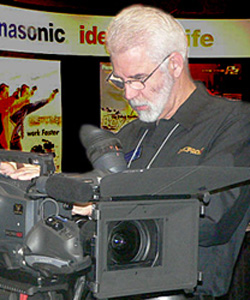
Reid Robertson
Reid is a Digital Camcorder Specialist with Panasonic Canada.
The instructions in most camera Operation Manuals are good, but occasionally omit a critical element.
Always remember when performing a “flange-back” adjustment (as Back Focus is sometimes called) the Iris should be FULLY OPEN. When the Iris is wide open, the depth of field is minimized, giving you the optimum focus point during your adjustment.
When there is too much light, use the ND filters in the filter wheel to cut it down to a useable level. If there are no ND filters available, use the “Poor Man’s ND”: higher Shutter speeds (this trick comes from the CCTV world). I cheat and also use the Viewfinder Peaking set to maximum, to find the best focus during the adjustment.
Rebuttals on Back Focus:
Just received your tech tips #9. With all respect, the suggestion to use max vf peaking, is suspect, in the same sense that doing a back focus at f/16 would be wrong. The idea is to make it more difficult, and more critical, than less so. My recommendation is always minimum (or just the least bit) of viewfinder peaking. – A. L. New York
**********
Hello DSC, a comment from someone who used to work for a HD colour viewfinder manufacturer – on Sony 730/750/900 we used to find that setting the VF peaking at about +70 (It goes from -99 to +99, with 0 being the default) gives a much better image on which to judge focus. Note, setting this peaking does NOT affect the image recorded to tape, it purely lifts the transitional edges slightly in the VF so that they “Snap In” at the point of critical focus. – RB London UK
**********
I guess by “difficult” the commenter means “difficult to be satisfied with what you see” rather than “difficult to obtain the desired result”?
Let us define “difficult” in the most common connotation of “difficult to do.” Then, less sensitive = MORE difficult to see and do. More difficult = LESS sensitive! You want it more sensitive, yes! But less difficult to see the right adjustment. That’s why you don’t use f/16, which makes it LESS sensitive and MORE difficult. Max peaking, on the other hand, lets you see a slight decrease in sharpness as you move away from the optimum point. MORE sensitive and LESS difficult. – WB Illinois
**********
Here’s the correct way to do it, real easy.
Open up the iris completely, and get your camera to deal with the light. Use any means available such as shutter and filter wheel to get the camera to deal with the lens wide open. Next zoom in completely and focus on your subject. Then zoom out completely and adjust back focus. Repeat a couple of times since these adjustments interact slightly.
This is the best way to do it, because this provides you with an individual back focus setting for your specific shot. Not a problem normally except if you have a really good lens coupled with a very good camera. Normally, you should just do this for a shot at infinity, and leave the lens set up this way for the next person using it.
Viewfinder peaking helps find the “sweet spot”, always maximize it if you need to. Main problem with Back Focus is that people don’t get that the Iris has to be WIDE open doing this.
Reason is simple. Before lenses we had pinhole cameras. They were really cool. A box with a pinhole in it and a piece of film on the other side. No problem with any focusing of the lens whatsoever, and always a great shot. Might take half an hour to get a good shot without anyone moving their face. Probably why old photos show grumpy looking people. – JK CA
**********
As far as I can tell, the cameramen I work with, who’ve also been doing this for 25+ years, do just the opposite of what this fellow above suggests.
They crank the living daylights out of their viewfinder peaking. Their objective is to make the image jump off the eyepiece and into their eyeballs when they’ve hit critical focus.
I do the same thing when I’m adjusting back focus, or doing other focus critical alignments.
LC – NY
**********
Setting VF peaking to max for back focus alignment, was also very suspect to me. Depending on the condition of VF and camera, it’s someTrebuchet MSecessary to use a certain amount of peaking in order to get the best result, but only in the very wide position of the zoom.
That’s how I do it sometimes, but as soon I zoom to the tele position, to adjust the focus, I turn down the peaking. That’s more work to do (especially when repeating the procedure many times…), but it pays.
I think, the max VF peaking might only be suitable for an “emergency setting” in the field, when no Siemens star is available and whatever is in front of the lens has to work as a test chart. Best regards from Switzerland – MR
**********
Gee, if we are going to turn the viewfinder peaking down, I guess we should go back inside the camera and turn off the enhancement contours like my engineer friends did back in the Norelco PC-70 days! That would help even more to make it nearly impossible to get meaningful results under field conditions.
Viewfinder peaking is on a display, therefore it enhances what you CAN see. If you would look at a waveform monitor you would see the same thing that peaking shows on the viewfinder – a very stark “snap” in and out of focus. Peaking (and the waveform monitor) is also helpful in cases where you are too far from the chart and it is too hard to see detail at the wide angle setting. How far should we be from that chart, anyhow? And repeat the process at least twice. DG Iowa

